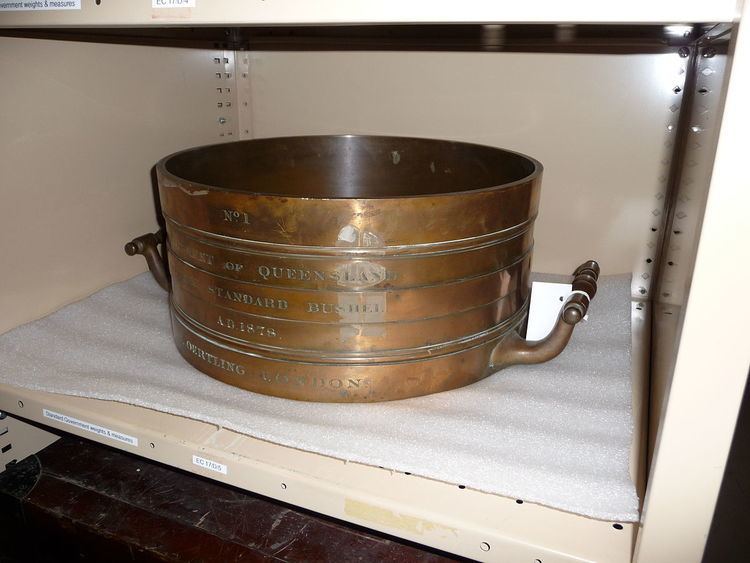1 imp bsh in ... ... is equal to ... | Symbol bsh or bu | |
 | ||
imperial units 6998302832942720000♠8 gal metric units 6998363687200000000♠36.36872 L | ||
A bushel (abbreviation: bsh. or bu.) is an imperial and US customary unit of weight or mass based upon an earlier measure of dry capacity. The old bushel was equal to 4 pecks or 8 gallons and was used mostly for agricultural products such as wheat. At present, the volume is usually only nominal, with bushels referring to standard quantities of mass instead. Two pecks make a kenning (obsolete), and four pecks make a bushel.
Contents
The name "bushel" is also used to translate similar units in other measurement systems.
Name
The name is an anglicization of the Old French boissiel and buissiel, meaning "little box". It may further derive from Old French boise, thus meaning "little butt".
History
The bushel is an intermediate value between the pound and ton or tun that was introduced following the Norman Conquest. Norman statutes made the London bushel part of the legal measure of English wine, ale, and grains. The Assize of Bread and Ale credited to Henry III c. 1266 defined this bushel in terms of the wine gallon, while the c. 1300 Assize of Weights and Measures usually credited to Edward I or II defined the London bushel in terms of the larger corn gallon. In either case, the bushel was reckoned to contain 64 pounds of 12 ounces of 20 pence of 32 grains.
These measures were based on the relatively light tower pound and were rarely used in Scotland, Ireland, or Wales during the Middle Ages. When the Tower system was abolished in the 16th century, the bushel was redefined as 56 avoirdupois pounds.
The imperial bushel established by the Weights and Measures Act of 1824 described the bushel as the volume of 80 avoirdupois pounds of distilled water in air at 62 °F (17 °C) or 8 imperial gallons. This is the bushel in some use in the United Kingdom. Thus there is no distinction between liquid and dry measure in the imperial system.
The Winchester bushel was the volume of a cylinder 18.5 in (46.99 cm) in diameter and 8 in (20.32 cm) high, which gives an irrational number of cubic inches. The modern American or US bushel is a variant of this, rounded to exactly 2150.42 cubic inches, less than one part per ten million less. It is also somewhat in use in Canada.
Weight
Bushels are now most often used as units of mass or weight rather than of volume. The bushels in which grains are bought and sold on commodity markets or at local grain elevators, and for reports of grain production, are all units of weight. This is done by assigning a standard weight to each commodity that is to be measured in bushels. These bushels depend on the commodities being measured and the moisture content. Some of the more common ones are:
Other specific values are defined (and those definitions may vary within different jurisdictions, including from state to state in the United States) for other grains, oilseeds, fruits, vegetables, coal, hair and many other commodities.
Government policy in the United States is to phase out units such as the bushel and replace them with metric mass equivalents.
Other units
The German bushel was the Scheffel.
The Polish bushel (korzec) was used as measure of dry capacity. It was divided into 4 quarters (ćwierć) and in the early 19th century had a value of 128 litres in Warsaw and 501.116 litres in Kraków.
The Spanish bushel (fanega) was used as a measure of dry capacity. It was roughly equal to 55.5 litres in Castille.
